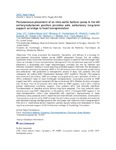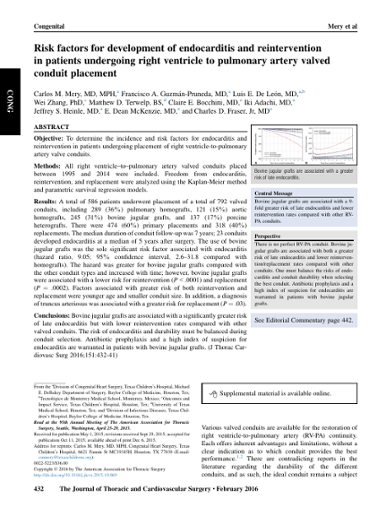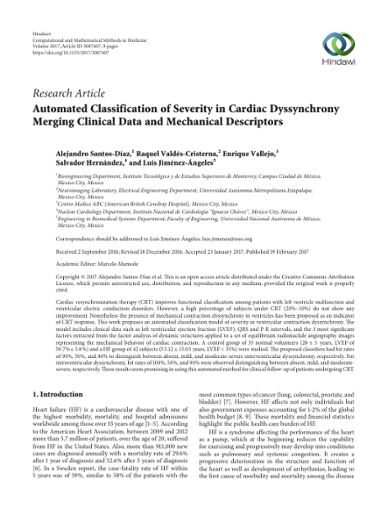| dc.creator | Guillermo Torre Amione | |
| dc.date | 2013 | |
| dc.date.accessioned | 2018-10-18T20:34:56Z | |
| dc.date.available | 2018-10-18T20:34:56Z | |
| dc.identifier.issn | 22131779 | |
| dc.identifier.doi | 10.1016/j.jchf.2013.06.002 | |
| dc.identifier.uri | http://hdl.handle.net/11285/630399 | |
| dc.description | Objectives: This study evaluated the feasibility, tolerability, and efficacy of a strategy for percutaneous intra-aortic balloon pump (IABP) placement through the left axillary-subclavian artery to provide mechanical circulatory support in patients with end-stage heart failure as a bridge to heart transplantation. Background: The transfemoral approach to IABP placement is associated with major disadvantages, including the risk for infection and limitation of patient mobility in those requiring extended support. Methods: We developed a percutaneous technique for placing IABPs in the left axillary artery that permits upright sitting and ambulation. We performed a retrospective review of data from patients who had undergone left axillary IABP implantation between 2007 and2012. Results: Fifty patients who received a left axillary IABP as a bridge to transplantation were identified, of whom 42 (84%) underwent heart or heart-multiorgan transplantation. Cumulative survival on IABP support was 92%, and post-transplant 90-day survival was 90%. Median duration of support was 18 days. Four of 50 patients (8%) died while on IABP support, and 3 (6%) received greater mechanical circulatory support. Four patients (8%) had clinically significant thromboembolic or bleeding events without long-term sequelae. The most common minor adverse event was IABP malposition, in 22 patients (44%). Prolonged IABP support in the heart-transplantation cohort was associated with significant improvements in mean pulmonary artery pressure and in creatinine and total bilirubin concentrations. Conclusions: Percutaneous insertion of an IABP through the left axillary artery is a feasible and relatively well-tolerated strategy tobridge patients with end-stage heart failure to heart transplantation. This form of mechanical-device treatment permits upright sitting and ambulation in those requiring extended support. © 2013 American College of Cardiology Foundation. | |
| dc.language | eng | |
| dc.relation | https://www.scopus.com/inward/record.uri?eid=2-s2.0-84885188993&doi=10.1016%2fj.jchf.2013.06.002&partnerID=40&md5=84561be600306745112f6ef519a59842 | |
| dc.relation | Investigadores | |
| dc.relation | Estudiantes | |
| dc.rights | info:eu-repo/semantics/openAccess | |
| dc.rights.uri | http://creativecommons.org/licenses/by-nc-nd/4.0 | |
| dc.source | JACC: Heart Failure | |
| dc.subject | bilirubin | |
| dc.subject | creatinine | |
| dc.subject | adult | |
| dc.subject | article | |
| dc.subject | assisted circulation | |
| dc.subject | balloon catheter | |
| dc.subject | balloon rupture | |
| dc.subject | bilirubin blood level | |
| dc.subject | cardiovascular disease | |
| dc.subject | clinical article | |
| dc.subject | clinical effectiveness | |
| dc.subject | cohort analysis | |
| dc.subject | controlled study | |
| dc.subject | creatinine blood level | |
| dc.subject | device removal | |
| dc.subject | feasibility study | |
| dc.subject | female | |
| dc.subject | guide wire | |
| dc.subject | heart failure | |
| dc.subject | heart transplantation | |
| dc.subject | human | |
| dc.subject | intraaortic balloon pump | |
| dc.subject | limb ischemia | |
| dc.subject | long term care | |
| dc.subject | lung artery pressure | |
| dc.subject | male | |
| dc.subject | mechanical circulatory support | |
| dc.subject | medical device complication | |
| dc.subject | needle | |
| dc.subject | orthotopic heart transplantation | |
| dc.subject | paresthesia | |
| dc.subject | pneumothorax | |
| dc.subject | priority journal | |
| dc.subject | retrospective study | |
| dc.subject | safety | |
| dc.subject | subclavian artery | |
| dc.subject | survival rate | |
| dc.subject | thromboembolism | |
| dc.subject | transient ischemic attack | |
| dc.subject | axillary artery | |
| dc.subject | heart assist device | |
| dc.subject | heart failure | |
| dc.subject | heart transplantation | |
| dc.subject | middle aged | |
| dc.subject | patient safety | |
| dc.subject | procedures | |
| dc.subject | prosthesis implantation | |
| dc.subject | time | |
| dc.subject | Axillary Artery | |
| dc.subject | Feasibility Studies | |
| dc.subject | Female | |
| dc.subject | Heart Failure | |
| dc.subject | Heart Transplantation | |
| dc.subject | Heart-Assist Devices | |
| dc.subject | Humans | |
| dc.subject | Intra-Aortic Balloon Pumping | |
| dc.subject | Male | |
| dc.subject | Middle Aged | |
| dc.subject | Patient Safety | |
| dc.subject | Prosthesis Implantation | |
| dc.subject | Retrospective Studies | |
| dc.subject | Subclavian Artery | |
| dc.subject | Time Factors | |
| dc.subject.classification | 7 INGENIERÍA Y TECNOLOGÍA | |
| dc.title | Percutaneous placement of an intra-aortic balloon pump in the left axillary/subclavian position provides safe, ambulatory long-term support as bridge to heart transplantation | |
| dc.type | Artículo | |
| dc.identifier.volume | 1 | |
| dc.identifier.issue | 5 | |
| dc.identifier.startpage | 382 | |
| dc.identifier.endpage | 388 | |
| refterms.dateFOA | 2018-10-18T20:34:56Z | |




